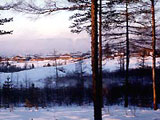 The Greater Xing’an Mountain region is the most northerly area in China. Cold as it is, the region is an attractive place to go because of its magnificent scenery of lush primeval forests, astronomical wonders of white night and the northern lights, and the unique ethnic flavor of the Oroqen people.
The Greater Xing’an Mountain region is the most northerly area in China. Cold as it is, the region is an attractive place to go because of its magnificent scenery of lush primeval forests, astronomical wonders of white night and the northern lights, and the unique ethnic flavor of the Oroqen people.
This is a famous Chinese song called Climbing the High Greater Xing’an Mountains.
Lying in China’s northeast border area, the Greater Xing’an Mountains are covered with vast expanses of virgin forests. The region is one of the country’s major forest areas, and is known as a green gem of northeast China.
With its high elevations and magnificent mountain scenery, the region is an ideal resort to escape the heat of summer, and in winter it turns into a spectacular shining world of ice and snow, offering lots of fun for tourists fond of skiing and skating.
The region is also a paradise for over 1,000 kinds of wild plants and 400 species of birds and animals, such as reindeer, sables, snow hares and brown bears. More than 20 rivers run through the deep valleys and the high mountains. The rivers and lakes are home to a rich variety of cold water fish, so visitors can enjoy lavish feasts of delicious fresh fish.
For many tourists, the most fascinating place in the area is perhaps the village of Mohe, also known as Arctic Village.
Located at the northern foot of the Greater Xing'an Mountains and facing the Chita and Amur regions in Russia across the Heilongjiang river, Mohe is the most northerly frontier village in China. Although it’s a long way to go from any other part of the country, and is quite cold even in summer, the place is a very famous tourist attraction because of its great scenic beauty and grand astronomical wonders, welcoming streams of visitors from home and abroad all year round.
The magnificent Heilongjiang, or Black Dragon, river, forms the boundary between China and Russia, and, of course, accounts for the name of Heilongjiang Province. Along the river banks visitors can wonder at splendid landscapes of snow-covered towering mountains and verdant forests.
Thanks to its high latitude, the village is the only place in China from where one can see the magical phenomena of the “white night” and the aurora borealis, or northern lights.
The white night refers to the special pale whiteness of the sky during the middle of the year, when it is daylight for almost 24 hours. At this time, around the summer solstice in June, the nights are but a short dimming of the sky. At 11 pm it is still light enough for you to read, write and play. By midnight, it is quite dim, but certainly not dark, and at one o’clock the day begins to break again, when, looking into the northern sky you can see the rosy glow of the early morning sun.
If you are lucky, for the night sky here is not always free of cloud, you can also see the compelling magic of the northern lights, a vast curtain of shimmering light suspended high in the earth’s atmosphere.
The Northern Lights come in many different shapes and colors. Sometimes they remain virtually motionless, shrouding the entire horizon in an eerie pool of pale light. Scandinavians call the northern lights the Dancing Lights, as they often jump around the sky, a masterpiece of celestial choreography.
For our scientifically-minded listeners, the northern lights are related to magnetic storms and the influx of charged particles from the sun.
At this high latitude, the summer lasts only for a month, and winter is long and cold, but with its own special beauty. Mohe village is a delightful picture of evergreen pine trees and dazzling white ice and snow under an azure blue sky. Horse-drawn sleighs are a common sight in the streets. For many visitors, especially those from places with little snow, it is an enchanting new world.
To promote the area’s unique attractions, the local government holds a tourist festival every year during the period of the summer solstice, when tens of thousands of tourists flock here to wonder at the pale eeriness of the white night, and join in festive activities with the locals around bonfires by the riversides.
This is a folk song of the Oroqen ethnic group titled Oroqen and the Xing’an Mountains, which describes the brave and uninhibited character of the Oroqen people.
Most people of the Oroqen nationality live in the deep forests of the Xing’an Mountains. They are expert horsemen and hunters, although, in order to protect the local wildlife, hunting is largely a thing of the past now. During their leisure hours, especially at festival time, they love to get together for some dancing and a good singsong.
The Oroqen still keep their traditional beliefs in Shamanism and totemic worship of nature. Visitors can visit any of their villages in the mountains to take a look at the unique life style and folk customs of this ethnic group. Wherever they go, the hospitable Oroqens will always give their guests a warm welcome.
The Greater Xing’an Mountains region is the coldest place in China, so if you plan a trip there in winter, be sure to take plenty of warm clothing with you.
To Get There, you can first go to Harbin, the capital of Heilongjiang province, by air or rail, and then take a 12-hour train ride to Jagdaqi, a major city in the Greater Xing’an Mountains region.
(CRI November 21, 2002)
|

